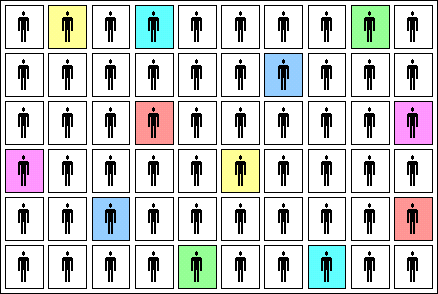|
Home Site Map CDs Witnessing thoughts Inviting thoughts Clouded mind |
||||
|
|
The following table symbolically explains the way in which thought patterns in the mind field can be colored with fear, aversion, attachment, egoism, or ignorance of our true nature (the five kleshas described by Yoga)(Yoga Sutra 1.5, 2.3). These colored thoughts (vrittis) are the obstacles blocking the light, peace, and joy of the core of our spiritual being. Reducing the coloring is the key to non-attachment (vairagya) and freedom.
See also: The Yoga Sutras explains that Yoga is the mastery (nirodhah) of the subtle thought patterns of the mind field (sutra 1.2), and that when this happens, the Seer, the True Self rests in its true nature (sutra 1.3), which is called Self-realization. Patanjali further explains that these interfering thought patterns are either colored (klishta) and lead to suffering, or they are uncolored (aklishta) and do not lead to suffering (sutras 1.5, 2.3). These thought patterns may be of people (such as the example above), objects, opinions, beliefs, or even the instruments with which we experience, including senses and subtle aspects of mind. They are the colorings of our samskaras, the deep impressions that drive our karma or actions. While the process of Yoga meditation has to do with the three practices of concentration, non-attachment, and expansion of the conscious state, the key to the process is the uncoloring of the negative or not-useful thoughts, allowing the klishta vrittis (colored thought patterns) to weaken into aklishta vrittis (uncolored thought patterns). The result is the realization of the Self that was there all along, under the layers of false identity. It is like removing the clouds that obscure the view of the deepest inner reality.
The process of reducing the five kleshas of fear, aversion, attachment, egoism, and ignorance of our true nature is somewhat like uncoloring the boxes in the examples above. The klishta vrittis gradually fade (in four stages) into aklishta vrittis through meditation and the many ancillary practices of Yoga. Eventually, they become completely uncolored (aklishta) in the inner fire of meditation. This does not mean that one becomes inert or robot-like, without enjoying life and the world. Rather, it means that the coloring is not dragging us around by our senses, either externally or internally. The thought patterns are not eliminated, but with the coloring attenuated, they lose their potency. The colored thought patterns become mere memories that can no longer control, disturb, or distract our attention. Meditation comes more easily as the colorings progressively become weaker. We can more greatly enjoy life in the world while realizing the spiritual truth of the center of consciousness, the realization of the Self.
-------
|
|
||



